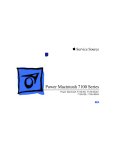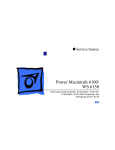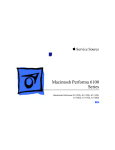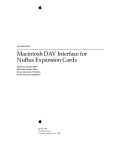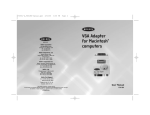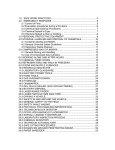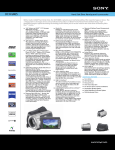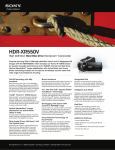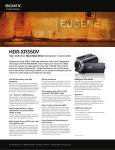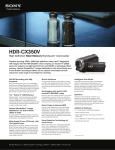Download Motorola Quadra 660AV Specifications
Transcript
K Service Source Centris 660AV/Quadra 660AV K Service Source Basics Centris 660AV/Quadra 660AV Basics Overview - 2 Overview This manual includes complete repair procedures for the Centris 660AV and Quadra 660AV shown at left. Figure: Centris 660AV and Quadra 660AV K Service Source Specifications Centris 660AV/Quadra 660AV Specifications Processors - 1 Processors Processor Motorola 68040 25 MHz Built-in paged memory management unit (PMMU), floating point unit (FPU), and 8K memory cache Addressing 32-bit registers 32-bit address/data bus Direct Memory Access (DMA) A Peripheral Subsystem Controller (PSC) provides direct memory access (DMA) between the 68040 buses and peripheral devices Specifications Digital Signal Processor (DSP) Processors - 2 AT&T DSP3210 32-bit floating-point digital signal processor Supports real-time tasks such as speech recognition, audio compression, and analog modem signal processing. Specifications Memory - 3 Memory RAM 8 MB (4 MB soldered DRAM plus 4 MB SIMM) standard, expandable to 68 MB 72-pin SIMMs 70 ns access time ROM 1 MB soldered on logic board PRAM 256 bytes of parameter memory Specifications VRAM Clock/Calendar Calendar Memory - 4 1 MB (two banks of 512K VRAM soldered on board) Maximum pixel depths for graphics: • 12-inch RGB (512 x 384) 24 bits per pixel • 13/14-inch RGB (640 x 480) 16 bits per pixel • 12-inch monochrome (640 x 480) 8 bits per pixel • 15-inch portrait (640 x 870) - 8 bits per pixel • 16-inch RGB (832 x 624) - 16 bits per pixel • 19-inch RGB (1024 x 768) - 8 bits per pixel • 21-inch monochrome (1152 x 870) - 8 bits per pixel • 21-inch RGB (1152 x 870) - 8 bits per pixel • VGA (640 x 480) - 16 bits per pixel • SVGA (800 x 600) - 16 bits per pixel CMOS custom chip with long-life lithium battery Specifications Disk Storage - 5 Disk Storage Floppy Drive 1.4 MB Apple SuperDrive Hard Drive 3.5 in., internal 80 or 500 MB hard drive CD-ROM Optional internal 5.25 in. CD-ROM drive Specifications I/O Interfaces - 6 I/O Interfaces Expansion Slot SCSI Internal expansion slot supports either NuBus, processor-direct slot (PDS) card, or digital audio/video expansion (DAVE) card (with appropriate adapter) One SCSI port; DB-25 connector Supports a maximum of six external devices (internal SCSI devices include the computer, which is always device 7) Apple Desktop Bus Two Apple Desktop Bus (ADB) ports for keyboard, mouse, and low-speed input devices; mini DIN-4 connectors Expansion Slot Internal expansion slot supports either a processor-direct slot card or 7-inch NuBus card (with appropriate adapter) Specifications Serial High-Performance Serial Port (Modem Port) Ethernet I/O Interfaces - 7 Two RS-232/RS-422 serial ports One mini DIN-8 port One mini DIN-9 high performance modem port 230.4 Kbps maximum Supports connection to analog, PBX, ISDN, facsimile (FAX), and data telephone lines Provides full-duplex telephone I/O at up to 14.4 Kbps AppleTalk and V.22, V22.bis, V.29, and V.32 modem protocols supported Supports Apple HiPPort protocols 0.92 Mbps maximum, clocked externally One Ethernet port; AUI-15 connector Specifications Audio Video I/O Interfaces - 8 One 16-bit stereo output port; one 16-bit stereo input port; stereo mini phone jack connectors Sample rates up to 48 kHz (44.1 kHz standard rate) Uses the digital signal processor (DSP) chip Supports stereo audio from internal CD drive Video monitor port; DB-15 connector Supports Apple monitors (up to 16 bits), NTSC, and PAL monitors Supports VGA and SVGA monitors (with adapter cables) Composite Video Input port; RCA phono connector Output port; RCA phono connector S-video Input port; DIN-7 connector Output port; DIN-4 connector Specifications I/O Devices - 9 I/O Devices Keyboard Mouse Microphone Standard, extended, or adjustable keyboard connected through two ADB ports Maximum power draw for all ADB devices: 500 mA Keyboard draws 25-80 mA ADB Mouse II; mechanical tracking optical shaft or contact encoding (low power) Draws up to 80 mA Optional electret, omnidirectional microphone Microphone output voltage is 4 mV peak to peak at normal value Mini phone plug connector Specifications Sound and Video - 10 Sound and Video Sound Generator Video Enhanced Apple sound chip (EASC), including four-voice wave table synthesis and stereo sampling generator capable of driving stereo mini phone-jack headphones or stereo equipment Built-in VRAM video support for all Apple monitors (requires an adapter for 21 in. monitors) Supports many types of NTSC, PAL, VGA Specifications Electrical - 11 Electrical A/C Line Voltage 100-240 VAC Frequency 50-60 Hz 86 W Power CMOS custom chip with long-life lithium battery Specifications Physical - 12 Physical Dimensions Weight Height: 3.4 in. (8.5 cm) Width: 16.3 in. (41.5cm) Depth: 15.6 in (39.7 cm) 14.0 lbs (6.4 kg) (weight varies based on internal devices installed) Specifications Environmental - 13 Environmental Operating Temperature Storage Temperature 10-40° C (50-104 ° F) -40 to 47° C (-40 F to 116.6° F) Relative Humidity Operating: 10-90% (noncondensing) Altitude 0-10,000 ft. (3,048 m) K Service Source Troubleshooting Centris 660AV/Quadra 660AV Troubleshooting General/ - 1 General The Symptom Charts included in this chapter will help you diagnose specific symptoms related to your product. Because cures are listed on the charts in the order of most likely solution, try the first cure first. Verify whether or not the product continues to exhibit the symptom. If the symptom persists, try the next cure. (Note: If you have replaced a module, reinstall the original module before you proceed to the next cure.) If you are not sure what the problem is, or if the Symptom Charts do not resolve the problem, refer to the Flowchart for the product family. For additional assistance, contact Apple Technical Support. Troubleshooting Symptom Charts/Error Chords - 2 Symptom Charts Error Chords One-part error chord sounds during startup sequence 1 2 3 Two-part error chord sounds during startup sequence 1 2 3 Disconnect SCSI data cable and hard drive power cable. Reboot system. If startup sequence is normal, run Macintosh Hard Disk Test and replace hard drive, if necessary. Disconnect floppy drive cable connector and reboot system. If startup sequence is normal, replace floppy drive. Replace logic board. Retain customer’s SIMMs. Replace DRAM SIMMs. Replace logic board. Retain customer’s SIMMs. Perform DRAM SIMM verification on replacement logic board. Troubleshooting Symptom Charts/System - 3 System Does not power on, screen is black, fan is not running, and LED is not lit 1 2 3 4 5 6 Check cables. Plug monitor directly into wall socket and verify that monitor has power. Remove third-party RAM and cards. Replace power cord. Replace power supply. Replace logic board. Retain customer’s SIMMs. Clicking, Chirping, or thumping 1 2 Replace power supply. Replace logic board. Retain customer’s SIMMs. Troubleshooting Symptom Charts/System (Continued) - 4 System (Continued) System shuts down intermittently System intermittently crashes or locks up 1 2 3 4 5 6 Make sure air vents are clear. Thermal protection circuitry may shut down system. After 30 to 40 minutes, system should be OK. Replace power cord. Check battery. Refer to “Battery Verification” in Additional Procedures. Replace power supply. Replace logic board. Retain customer’s SIMMs. 1 2 3 4 5 6 Verify that system software is correct version. Disconnect external SCSI devices. Verify that application software is known-good. Replace SIMMs. Replace logic board. Retain customer’s SIMMs. Replace power supply. Troubleshooting Symptom Charts/Floppy Drive - 5 Floppy Drive Audio and video present, but internal floppy drive does not operate 1 2 3 4 5 6 7 Replace disk with known-good. Verify that all external SCSI devices are disconnected. Replace floppy drive cable. Replace floppy drive. Replace logic board. Retain customer’s SIMMs. Replace power supply. Disk ejects, display shows icon with blinking “X” 1 2 3 4 Replace disk with known-good system disk. Replace internal floppy drive cable. Replace internal floppy drive. Replace logic board. Retain customer’s SIMMs Troubleshooting Symptom Charts/Floppy Drive (Continued) - 6 Floppy Drive (Continued) Does not eject disk 1 2 3 4 Attempt to eject disk, but doesn’t 1 2 3 4 Switch off computer. Hold mouse button down while you switch computer on. Replace floppy drive cable Replace internal floppy drive. Replace logic board. Retain customer’s SIMMs Push disk completely in. Reseat floppy drive bezel and drive so bezel slot aligns correctly with drive. Eject disk manually. Replace floppy drive. Troubleshooting Symptom Charts/Floppy Drive (Continued) - 7 Floppy Drive (Continued) MS-DOS drive does not recognize disk formatted on 1.4 MB drive 1 2 To read and write files with either MS-DOS or 1.4 MB drive, format all disks with MS-DOS drive first. Verify the software is loaded. Internal floppy drive runs continuously 1 2 3 4 5 Replace disk with known-good system disk. Remove external SCSI devices. Replace internal floppy drive cable. Replace internal floppy drive. Replace logic board. Retain customer’s SIMMs. Troubleshooting Symptom Charts/Video - 8 Video Screen is black, audio and at least one drive operate, fan is running, and LED is lit 1 Adjust brightness. See Adjustments chapter in appropriate monitor manual. 2 Check cables. 3 Verify that monitor is switched on. 4 Clear parameter RAM. Hold down <Command> <Option> <P> <R> during startup but before “Welcome To Macintosh” appears. 5 Replace video cable. 6 Replace monitor. Refer to appropriate monitor manual to troubleshoot defective monitor. 7 Replace video card, if present 8 Replace SIMMs. 9 Replace logic board. Retain customer’s SIMMs. 10 Replace power supply. Troubleshooting Symptom Charts/Video (Continued) - 9 Video (Continued) Screen is black, audio and drive do not operate, but fan is running and LED is lit 1 2 3 4 5 6 Remove peripherals and cards. Remove expansion card. Replace DRAM SIMMs. See Memory manual. Replace power supply. Replace logic board. Partial or whole screen is bright and audio is present, but no video information is visible 1 Replace monitor. Refer to appropriate monitor manual to troubleshoot defective monitor. Replace video cable. Replace video card, if installed. Clear parameter RAM. Hold down <Command> <Option> <P> <R> during startup but before “Welcome To Macintosh” appears. Replace logic board. Retain customer’s SIMMs. 2 3 4 5 Troubleshooting Symptom Charts/Hard Drive - 10 Hard Drive Internal hard drive will not operate; drive doesn’t spin 1 2 3 4 Replace SCSI data cable. Replace hard drive. Replace power supply. Replace logic board. Retain customer’s SIMMs. Drive does not appear on the desktop 1 2 Verify that there are no duplicate SCSI device addresses. Clear parameter RAM. Hold down <Command> <Option> <P> <R> during startup but before “Welcome To Macintosh” appears. Verify that drive is initialized. If it isn’t, use “HD SC Setup” to initialize drive. Replace SCSI data cable. Replace hard drive. 3 4 5 Troubleshooting Symptom Charts/Hard Drive (Continued) - 11 Hard Drive (Continued) Works with internal or external SCSI devices but not with both 1 2 3 4 Verify that there are no duplicate SCSI device addresses. Replace terminator on external device. Replace external SCSI data cables. Refer to appropriate manual to troubleshoot defective external device. Troubleshooting Symptom Charts/CD-ROM drive - 12 CD-ROM drive CD-ROM drive does not accept a compact disc 1 2 3 Exchange disc (if disc is dirty or damaged). Verify that CD-ROM carrier is installed properly. Replace CD-ROM drive mechanism. Macintosh does not display CD-ROM drive icon 1 2 3 4 Verify that CD-ROM extension is in System Folder. Replace SCSI data cable. Replace CD-ROM drive mechanism. Replace logic board. Compact disc won’t eject from the drive 1 2 Manually eject the compact disc. Press the eject button behind the front bezel (if it is accessible). Replace the CD-ROM drive mechanism. 3 Troubleshooting Symptom Charts/Peripheral - 13 Peripheral Cursor does not move 1 2 5 Check mouse connection. Inspect inside of mouse for buildup of dirt or other contaminants. Clean mouse if necessary. If mouse was connected to keyboard, connect it to computer ADB port instead. If mouse works, replace keyboard or ADB cable. If mouse does not work in any ADB port on computer, replace mouse. Replace logic board. Retain customer’s SIMMs. 1 2 Replace mouse. Replace logic board. Retain customer’s SIMMs. 3 4 Cursor moves, but clicking mouse button has no effect Troubleshooting Symptom Charts/Peripheral (Continued) - 14 Peripheral (Continued) Cannot double-click to open application, disk, or server 1 2 3 6 Remove duplicate System files from hard drive. Clear parameter RAM. Hold down <Command> <Option> <P> <R> during startup but before “Welcome to Macintosh” appears. If mouse was connected to keyboard, connect mouse to computer ADB port instead. If mouse works, replace keyboard or ADB cable. If mouse does not work in any ADB port on computer, replace mouse. Replace logic board. Retain customer’s SIMMs. 1 2 3 4 Check keyboard connection to ADB port. Replace keyboard cable. Replace keyboard. Replace logic board. Retain customer’s SIMMs. 4 5 No response to any key on keyboard Troubleshooting Symptom Charts/Peripheral (Continued) - 15 Peripheral (Continued) Known-good serial printer will not print 1 2 3 4 Verify that system software is correct version. Make sure Chooser and Control Panel settings are correct. Replace printer interface cable. Replace logic board. Retain customer’s SIMMs. Known-good printer on a network will not print 1 2 3 4 Verify that system software is correct version. Make sure Chooser and Control Panel settings are correct. Refer to Networks manual. Replace logic board. Retain customer’s SIMMs. Troubleshooting Symptom Charts/Miscellaneous - 16 Miscellaneous No sound from speaker 1 2 3 4 Verify that volume setting in Control Panel is 1 or above. Check speaker cable. Replace speaker. Replace logic board. Retain customer’s SIMMs. Sound from external video source does not record or play through speakers 1 Verify that audio cable connects sound source to sound input port when using S-video. Check speaker cable. Replace speaker. Replace logic board. Retain customer’s SIMMs. 2 3 4 K Service Source Take Apart Centris 660AV/Quadra 660AV Take Apart Top Cover - 1 Top Cover Top Cover Tab Tab No preliminary steps are required before you begin this procedure. 1 2 Press up on the tabs at the back of the top cover. Tilt the back of the top cover and remove the top cover. Take Apart Power Supply - 2 Power Supply Power Supply Before you begin, do the following: • remove the top cover. • Review the ESD precautions in Bulletins/ Safety. Take Apart Power Supply - 3 1 Power Supply Remove the screw that secures the power supply. Take Apart Power Supply Power Supply - 4 2 Tab Floppy Drive For easier access to the power supply, release the floppy drive mounting tabs. Slide the floppy drive forward a few inches. Take Apart Power Supply - 5 3 CD-ROM Audio Cable 4 SCSI Data Cable CD-ROM Drive Power Cable If a CD-ROM drive is present, disconnect the SCSI data cable and CDROM drive power cable from the CD-ROM drive. Disconnect the CD-ROM audio cable. Take Apart Power Supply - 6 5 CD-ROM EMI Shield Remove the CD-ROM drive EMI shield. Take Apart Power Supply - 7 6 Tab Press up on the tab and slide out the CD-ROM drive. Take Apart Main Power Cable Power Supply - 8 7 CD-ROM Drive Power Hard Drive Power Cable Disconnect these power supply cables: • Main power cable from the logic board • Hard drive power cable from the hard drive • CD-ROM drive power cable from the CDROM drive (if installed) Take Apart Power Supply - 9 8 Power Supply Slide the power supply forward slightly. Take Apart Power Supply - 10 9 Power Switch Tilt the front of the power supply and lift it out of the computer. Replacement Note: Move the floppy drive forward. Press the actuator toward the back of the computer to properly seat the power switch in the actuator. Take Apart Logic Board - 11 Logic Board Logic Board Before you begin, do the following: • Remove the top cover • Remove the Power supply • Review the ESD precautions in Bulletins/ Safety. Take Apart Logic Board - 12 Note: The logic board is secured with two screws. Standoff with Internal Screw 1 2 3 Phillips Screw Using a long Phillips screwdriver, remove the screw from the center of the standoff. Remove the standoff. Remove the Phillips screw from the front edge of the logic board. Take Apart Logic Board - 13 LED Cable 4 5 Floppy Drive Cable Speaker Cable Disconnect these cables from the front edge of the logic board: • Floppy drive cable • Speaker cable • LED cable • CD-ROM audio cable (if present) Note: Lift the front edge of the logic board to make removing the floppy drive cable easier. Take Apart Logic Board - 14 SCSI Data Cable Video-out cable Video-in cable 6 Disconnect these cables from the back edge of the logic board: • Video-out cable • Video-in cable • SCSI data cable Take Apart Logic Board - 15 7 CD-ROM Drive EMI Shield Hard Drive EMI Shield Remove the EMI shield from the hard drive bay and from the CD-ROM bay, if the CD-ROM drive is installed. Take Apart Logic Board - 16 8 9 Tab Release the tab to unlock the hard drive or CDROM, if installed. Slide forward the hard drive and CD-ROM drive, if installed. Take Apart Logic Board - 17 Logic Board 10 Slide the logic board about 1/2 inch toward the front of the computer. Take Apart Logic Board - 18 11 Remove the logic board. Logic Board 12 Replacement Note: Slide the hard drive and optional CD-ROM drive forward a bit to allow room for the logic board. Connect the floppy drive cable before securing the logic board. Take Apart Floppy Drive - 19 Floppy Drive Floppy Drive Before you begin: • remove top cover. • Review the ESD precautions in Bulletins/ Safety. Take Apart Floppy Drive - 20 1 Floppy Drive Tab Tab Press the tabs outwards and slide the floppy drive forward a few inches. Take Apart Floppy Drive - 21 2 Floppy Drive Cable 3 Disconnect the floppy drive cable. Note: You can easily reach the floppy drive cable connector when the floppy drive is forward. Slide out the floppy drive. Take Apart Hard Drive - 22 Hard Drive Hard Drive Before you begin: • remove top cover. • Review the ESD precautions in Bulletins/ Safety. Take Apart Hard Drive - 23 SCSI Data Cable Hard Drive Power Cable 1 Disconnect the SCSI data and hard drive power cables from the hard drive. Take Apart Hard Drive - 24 2 Hard Drive EMI Shield Remove the hard drive EMI shield. Take Apart Hard Drive - 25 3 Tab Press down on the tab and slide out the hard drive. Take Apart CD-ROM Drive - 26 CD-ROM Drive CD-ROM Drive Before you begin: • remove the top cover. • Review the ESD precautions in Bulletins/ Safety. Take Apart CD-ROM Drive - 27 1 CD-ROM Audio Cable 2 CD-ROM Power Cable SCSI Data Cable Disconnect the SCSI data cable and CD-ROM drive power cable from the CD-ROM drive. Disconnect the CD-ROM audio cable. Take Apart CD-ROM Drive - 28 3 CD-ROM EMI Shield Remove the CD-ROM drive EMI shield. Take Apart CD-ROM Drive - 29 4 Press up on the tab and slide out the CD-ROM drive. Replacement Note: Be sure to remove the CD-ROM drive from the carrier prior to returning the drive to Apple. Tab Take Apart Internal Chassis and Speaker - 30 Internal Chassis Internal Chassis Support Post Rail and Metal Tab Tab Internal Chassis and Speaker Before you begin: remove the following: • Remove the top cover • Remove the power supply • Remove the floppy drive • Remove the hard drive • Remove the CD-ROM drive (if installed) • Remove the logic board • Review the ESD precautions in Bulletins/ Safety. Note: The chassis is secured to the bottom cover by two Take Apart Internal Chassis and Speaker - 31 Internal Chassis tabs at the front of the unit, two rail and tab sets at the sides of the unit, support posts at the back of the chassis, and hidden brackets that slide into the bottom cover. 1 2 3 Press up on one of the front tabs while lifting the support post. Repeat this step on the other side until the internal chassis slides easily toward the back of the computer. Press down and slide the chassis toward the back Take Apart Internal Chassis and Speaker - 32 4 of the computer. Remove the chassis. Note: The LED cable, floppy drive cable, speaker and speaker cable are not shipped with the replacement internal chassis. Take Apart Internal Chassis and Speaker - 33 Speaker Cable LED Cable Floppy Drive Cable 5 Turn the chassis over. 7 Remove the speaker cable from its routing guides. 6 Remove the floppy drive cable and the LED cable. Take Apart Torx Screw Internal Chassis and Speaker - 34 Speaker 8 9 Remove the two torx screws from the speaker. Lift out the speaker. Take Apart Bottom Cover Internal Chassis Metal Tab Rail Internal Chassis and Speaker - 35 Replacement Note: Place the internal chassis on the floor of the bottom cover with the front of the chassis about 3/4 inch from the front of the cover. Align the side rails with the metal tabs and slide the rails under the metal tabs. Take Apart Internal Chassis and Speaker - 36 Replacement Note: After carefully aligning the side rails, push down firmly on the chassis and slide it toward the front of the unit. The tabs will snap into place. Take Apart Bottom Cover - 37 Bottom Cover Bottom Cover Before you begin: remove the following: • Remove the top cover • Remove the power supply • Remove the floppy drive • Remove the hard drive • Remove the CD-ROM drive (if installed) • Remove the logic board • Remove the internal chassis • Review the ESD precautions in Bulletins/ Safety Take Apart Bottom Cover - 38 1 2 Actuator 3 Tab Tab Shift the actuator toward the back of the unit. Squeeze together the tabs on the shaft of the actuator. Remove the actuator. Take Apart Bottom Cover - 39 4 Insulator Sheet Lift out the insulator sheet. Replacement Note: There is only one correct position for the insulator sheet. Match the notches on the sides of the insulator sheet with the corresponding metal stops. Take Apart Bottom Cover - 40 5 I/O Panel Tabs Tabs 6 Using a screwdriver, release the tabs on the upper-rear edge of the bottom cover. Push out the I/O panel. K Service Source Upgrades Centris 660AV/Quadra 660AV Upgrades Expansion Cards - 1 Expansion Cards Expansion Card Slot Before you begin, do the following: • Remove the top cover. • Review the ESD precautions in Bulletins/ Safety. Upgrades Expansion Cards - 2 Expansion Port Cover 1 Remove the expansion port cover from the back panel. Upgrades Expansion Cards - 3 Expansion Card 2 3 Adapter Card Loosely connect the expansion card connector to the adapter card connector. Note: Be sure to fit the adapter card pin into the expansion card hole. Gently press the connectors together. Upgrades Expansion Cards - 4 4 Adapter Card Tab Adapter Card Connector Bottom Case Slot Expansion Slot Insert the connector on the bottom of the adapter card into the expansion slot. Note: Make sure that the tab on the side of the adapter card slides into the slot on the side of the bottom case. Upgrades Expansion Cards - 5 5 Thumbscrews Attach the thumbscrews. Upgrades CD-ROM Drive Upgrade - 6 CD-ROM Drive Bay CD-ROM Drive Upgrade Before you begin, do the following: • Remove the top cover. • Review the ESD precautions in Bulletins/ Safety. Upgrades CD-ROM Drive Upgrade - 7 1 2 Slotted CD-ROM Drive Bezel Remove the blank CDROM drive bezel from the top cover. Install the slotted CDROM drive bezel in the top cover. Upgrades CD-ROM Drive Upgrade - 8 3 5.25'' Drive Bay Shield Pry off the metal 5.25” drive bay shield. Upgrades CD-ROM Drive Upgrade - 9 CD-ROM Drive Carrier CD-ROM Drive 4 Attach the CD-ROM drive carrier to the CD-ROM drive with four Phillips screws. Upgrades CD-ROM Drive Upgrade - 10 CD-ROM Drive CD-ROM Drive Carrier 5 Push in the CD-ROM drive and carrier. Upgrades CD-ROM Drive Upgrade - 11 6 Bottom Cover 7 Tabs Slots Align the slots at the lower edge of the CDROM shield with the tabs on the bottom cover. Swing up the CD-ROM shield until it snaps securely onto the bottom cover. Upgrades CD-ROM Audio Cable SCSI Data Cable CD-ROM Drive Upgrade - 12 CD-ROM Drive Power Cable 8 9 CD-ROM Cable Audio Connect these cables from the power supply to the CD-ROM drive: • CD-ROM audio cable • SCSI data cable • CD-ROM drive power cable Connect the other end of the CD-ROM audio cable to the logic board. Upgrades Power Mac Upgrade - 13 Power Mac Upgrade No preliminary steps are required before you begin this procedure. The Centris 660AV and Quadra 660AV can be upgraded to a Power Macintosh 6100/60 or Power Macintosh 6100/ 60AV. For upgrade instructions, refer to Additional Procedures in the Power Macintosh 6100 manual. K Service Source Additional Procedures Centris 660 AV/Quadra 660AV Additional Procedures Battery Battery Verification - 1 Battery Verification Before you begin do the following: • Remove the top cover. Warning: If handled or discarded improperly, the lithium battery in the computer could explode. Review battery-handling and disposal instructions in Bulletins/Safety. • Review the ESD precautions in Bulletins/ Safety. Additional Procedures Battery Verification - 2 1 2 Negative Probe Positive Probe 3 Set the voltmeter to the 10 volts DC scale. Hold the positive probe of the voltmeter to the positive end of the battery (marked “+” on the logic board) and the negative probe to the negative end of the battery. If the battery voltage is below 3.2 volts, replace the battery. Refer to “Battery Replacement” in this chapter. Additional Procedures Battery Battery Replacement - 3 Battery Replacement Before you begin do the following: • Remove the top cover. Warning: If handled or discarded improperly, the lithium battery in the computer could explode. Review battery-handling and disposal instructions in Bulletins/Safety. • Review the ESD precautions in Bulletins/ Safety. Additional Procedures Battery Replacement - 4 1 Using a small flat-blade screwdriver, pry open the latch at the end of the battery holder and lift off the cover. Additional Procedures Battery Replacement - 5 2 3 Grasp the battery and remove it from the holder. Return the battery to Apple for proper disposal. For battery packaging and labeling instructions, refer to the safety information in Bulletins/Safety. K Service Source Exploded View Centris 660AV/Quadra 660AV Exploded View 1 Exploded View Top Cover 922-0545 Blank Bezel 922-0358 Slotted CD Bezel with Caddy 922-0355 Slotted CD Bezel Caddiless SCSI Cable Power Supply 661-1688 Support Column 922-0356 Internal Chassis 922-0359 Logic Board 661-1704 Floppy Drive Cable 922-0351 Speaker 922-0353 LED Cable 922-0354 Insulator Sheet 922-0866 On/Off Actuator 922-0357 AV Adapter Cables CD Audio Cable 922-0842 Manual Insert Floppy Drive Floppy Drive Carrier 805-0961 Expansion Port Cover 922-0902 Rear Housing 922-0864 Feet (4) 922-0862 Bottom Cover 922-0806 Floppy Shield 922-0826 * CD-ROM Drive Hard Drive* Hard Drive Carrier 922-1806 PDS Adapter NuBus Adapter 661-1719 CD-ROM Hard Drive Shield Carrier 922-0850 922-0367 CD-ROM Shield 922-0826 This is a generic representation of a product family. Configurations may vary. For number of part with asterisk, see parts list. Blank Shield

































































































